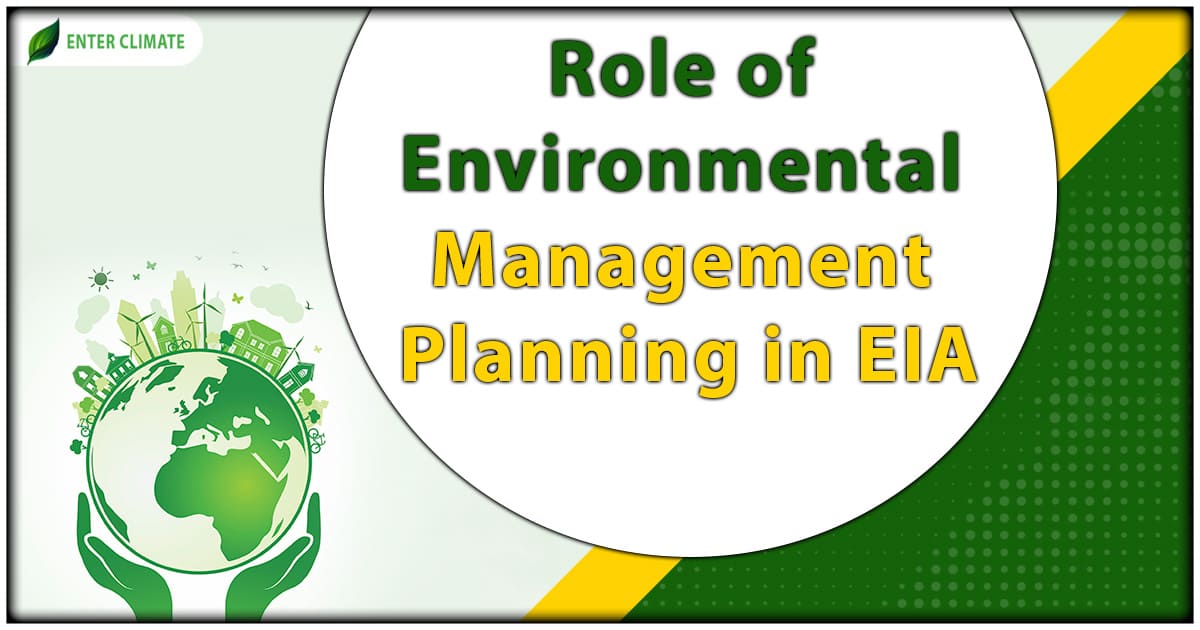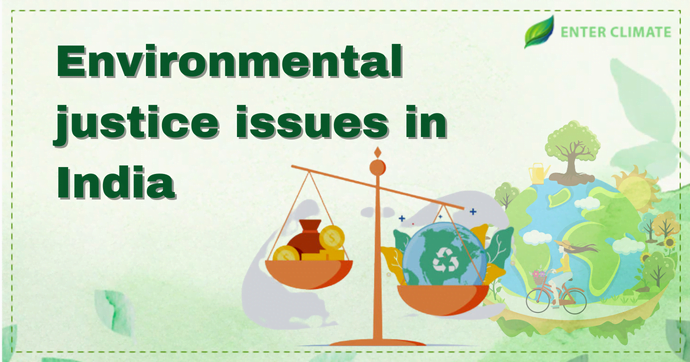Role of Environmental Management Planning in EIA
 21 Jul, 2023
21 Jul, 2023 
An Environment Management Plan (EMP) is formulated to evaluate the ecological consequences of an upcoming project at the proposed site. The primary objective of EMP is to plan to provide a designed solution for all possible issues arising from the construction and operation of a developmental project. Therefore, EMP is implemented on the project’s site and minimises the adverse effects while maximising the benefits to the stakeholders from the project. The plan encompasses a set of measures for mitigating, managing, monitoring and instituting actions to be implemented during the project’s execution and operation, aiming to eliminate or reduce negative environmental impacts to acceptable levels. The following are some of the planning areas under the EMP.
• Pollution Prevention and Abatement Plan
• Waste Management Plan
• Storm Water Management Plan
• Spill Management Plan
• Wildlife Management Plan
• Road Safety and Traffic Management Plan
• Occupational Health & Safety Management Plan
• Management of Social Issues and Concerns
• Site Closure Plan
Objective of EMP
EMP are commonly generated during the environmental impact assessment (EIA). If the planned activity is accepted, the approval conditions frequently reference the management plans. Additionally, the approval requirements may necessitate the endorsement of an updated or supplementary report on the environmental management plan before commencing the permitted action.
- Identifying strategies to mitigate environmental impacts for each component, including prevention, control, restoration, and resettlement.
- Establishing a monitoring system to ensure compliance with the specified conditions.
- Developing an implementation strategy that includes schedules and allocation of resources.
- Serving as the foundation for the proponent’s environment management program[1], demonstrating that the environmental impacts arising from the proposed or existing activity, including cumulative effects, can be effectively managed.
- Creating a document that clearly justifies why the proposed or existing activity should be deemed environmentally acceptable by the relevant authority.
Requirement of EMP for Developmental Projects
EMP requirements include the following:
- Clearly define the individuals responsible, the locations, the specific actions, and the timelines for executing environmental management and mitigation measures.
- Provide regulatory bodies, companies, contractors, developers, and other stakeholders with improved control over on-site environmental management throughout the project’s duration.
- Enable project advocates/defenders to ensure that their contractors fulfil environmental obligations on their behalf.
- Demonstrate the exercise of due diligence.
- Include a description of the standard content of the report.
- Establish procedures for document control.
The environmental management plan report should outline the training measures to be implemented, which may include:
- Site inductions.
- Identification of environmentally significant areas and relevant environmental matters.
- Understanding the requirements of the EMP and the individual’s associated role.
- Procedures for responding to environmental incidents and emergencies.
- Site-specific environmental controls.
- Every training session should be documented, including:
- The name of the trainee.
- The date of the training.
- The name of the trainer.
- A description of the training provided.
Importance of Environmental Management Plan
The significance of an EMP is as follows:
- Promotes the adoption of effective management practices by incorporating environmental considerations into project planning and demonstrating a commitment to environmental issues.
- Describes the reporting and regular evaluation of environmental management activities and performance.
- Provides rational and practical environmental guidelines to minimise the potential environmental impact of activities.
- Helps minimise various forms of environmental disturbances, including physical, biological, ecological, socioeconomic, cultural, and archaeological aspects.
- Combats pollution by monitoring and managing air, noise, land, water, waste, energy, and natural resources.
- Protects sensitive or endangered flora and fauna and prevents land degradation.
- Ensures compliance with applicable environmental laws, regulations, standards, and guidelines.
- Promotes best practices in waste management, encompassing prevention, minimisation, recycling, treatment, and disposal for all types of waste (liquid and solid).
- Specifies the necessary monitoring procedures to identify environmental impacts accurately.
- Ensures that employees and contractors receive appropriate training and awareness regarding their environmental obligations and compliance.
- Reduces environmental risks and improves health, safety, and environmental (HS&E) conditions.
- Enhances efficiency by reducing consumption and conserving energy, and depleting resources.
- Includes a comprehensive plan addressing the questions of what, where, when, how, and who in relation to environmental management activities.
How to prepare an Environmental Management Plan for your project?
Stage 1: Draft an Environmental Policy
The initial step involves establishing an Environmental Policy that aligns with the organisation’s objectives.
Stage 2: Planning
This stage entails identifying regulatory requirements, assessing processes, resources, and significant impacts, exploring opportunities for pollution prevention, setting objectives and improvement targets, and developing a planning, programming, and budgeting system.
Stage 3: Implementation
The implementation phase defines the structure, responsibilities, and programs. Conducting training, creating documentation for the Environmental Management System (EMS) such as document control and record keeping, communicating the EMS to personnel, developing and implementing standard operating procedures (SOPs), and establishing emergency preparedness and response procedures.
Stage 4: Monitoring
This step involves monitoring and measuring activities through internal assessments, identifying issues and their causes, executing corrective and preventative actions, and conducting an EMS review.
Stage 5: Monitoring
During the management review process, upper management evaluates the EMS, considering the results of internal evaluations. Changes to the EMS are made as necessary to ensure compliance. The management review aims to continuously improve the EMS based on the outcomes of the checking and corrective actions carried out in stage 4.
Documents Required in Environmental Management Planning
The necessary documents for developing an EMP include the following:
- Specific details related to the project activities, such as the projected area allocation, water requirements, waste generation, etc.
- Information regarding the project’s utilisation of natural resources or materials that may have toxic or destructive properties.
- Assessment of pollution sources in the air, soil, and rivers.
- Evaluation of noise, vibration, as well as light and heat emissions resulting from the project.
- Consideration of potential accidents or incidents.
- Identification of variables that may have cumulative or consequential impacts.
- General project information.
- Identification of environmentally sensitive areas in the vicinity of the project site.
- Site/layout plan.
- Documentation verifying the installation of machinery.
- Proof of land ownership.
- Identification documentation of the authorised signatory.
- Quality test reports.
- Evidence of adopted mitigation measures.
Conclusion
Environmental Management Plans assist the proponent in identifying and describing mitigation and compensation measures to address all impacts during the assessment. EMP leads to physical planning and the development of a work schedule, timeline, and specific locations for implementing the mitigation and compensation measures. Such plans assist in the financial planning, including budgetary estimates for implementing the mitigation measures and demonstrating their incorporation into the overall project budget. A carefully drafted EMP will benefit the proponent as well as the local stakeholders. Therefore, deciding on assistance for the EMP is a crucial stage in the EIA process and must be done by NABET-qualified environmental consultants with a proven record in formulating such plans.
FAQs
An EMP is a product of the Environmental Impact Assessment (EIA) process. It outlines the strategies for implementing and monitoring impact mitigation measures.
Environmental management plans provide a detailed account of how an action or project could affect the surrounding natural environment. They also establish explicit commitments from the responsible party regarding how they will prevent, minimise, and manage these impacts to ensure they are environmentally acceptable.
EMP is a customised strategy created to guarantee that the project is carried out in an environmentally responsible way, considering the possible environmental hazards associated with the proposed project and implementing suitable measures to reduce those risks.
The Environmental Management Plan (EMP) is a document that provides guidance on assessing and fulfilling a project’s environmental protection and mitigation requirements. These requirements usually pertain to obtaining project permits or approvals and are aimed at ensuring compliance with environmental standards. The EMP is a tool to measure and facilitate adherence to these requirements.
The Environmental Management & Reporting services encompass the creation of plans to safeguard and preserve various conservation areas such as bushland, foreshores, fauna habitats, wetlands, and other similar ecological regions.
The process involves defining the organisation’s goals for the Environmental Management System (EMS), obtaining a commitment from top management, selecting an EMS champion, assembling an implementation team, conducting a kick-off meeting, and performing a preliminary review.
The steps of environmental management plan are commitment, planning, implementation, evaluation, and review.
Environmental reporting involves taking scientific information and presenting it in a manner that is easily understandable and accessible to audiences who may not have technical expertise in the subject matter.
Environment Management is the active management of societal impact on the environment.
The four main components of the environmental management plan are as follows: Mitigation Program, Monitoring Program, Recommendations, and EMP Implementation Program.
Read our Article: Why Environmental Compliance Assessment Is Needed After Obtaining EC?
Categories
Latest Post
Air pollution Dispersion Modeling
Natural Disaster Risk Assessment
Endangered Species Protection
Aquifer Recharge Project
Sustainable Sanitation Solutions














